This not my first loudspeaker build but it is my first OB build. I am ready to set them up and play with them a bit. Unfortunately I have no measurement equipment yet. Maybe for Christmas. I used drivers I had laying around. The Mid/High arrangement is Seas H653 Coax (not the best for OB). I axially mounted the matching tweeter (Seas 25TFFN) to the back of the coax magnet with 4mm allthread and a threaded standoff because the tweeter magnet is pre threaded. Not sure if axially mounting the tweeter makes any difference one way or the other but it seemed as good a place to start as any. I have done quite a bit of reading on OB design. There is so much information and opinion that I felt I would be better off just jumping in and working out the issues myself through testing. The Bass section is 4 Exodus DPL-10s that I bought on sale. I didn’t like the big rubber gaskets they came with so I ditched them (may be a mistake as far as vibration) and cut aluminum rings to flush mount them. The Baffle is 27” wide by 32” tall. My plan at this point is the run them 4 way for the first test. Separate amps/channels for front tweet, rear tweet, midrange, and bass. I have the active crossovers and amps on my current system so it is just a matter of plugging them in. running the tweeters separate will allow me to play with the front and rear phase and gain. I will probably find some major issues with this design but I am up for it and I have to start somewhere. I probably should have built test baffles first, but doing it this way also served to try out a new router I bought and also allowed me to polish my wood finishing techniques a bit. I made the baffles out of ¾” red oak plywood (which upon assembly feels a bit thin). This concerns me but we will see. I may be able to minimize the resonance/buffeting by wiring 2 of the woofers out of phase. I dado cut 2” wide ¾” thick solid red oak for the framing. The legs and all the hardware I water jet cut out of aluminum. At any rate, take a look at the pics. Let me know what you think. I will keep you posted on the tests.
Matthew
Matthew
Attachments
-
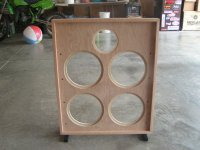 PICT0313.JPG322.8 KB · Views: 509
PICT0313.JPG322.8 KB · Views: 509 -
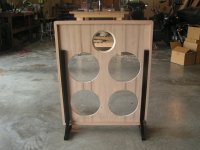 PICT0315.JPG326 KB · Views: 481
PICT0315.JPG326 KB · Views: 481 -
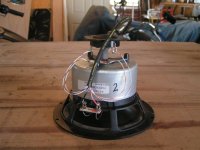 PICT0320.JPG353.5 KB · Views: 463
PICT0320.JPG353.5 KB · Views: 463 -
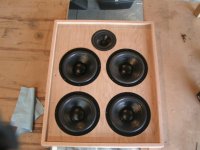 PICT0325.JPG362.2 KB · Views: 460
PICT0325.JPG362.2 KB · Views: 460 -
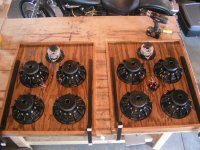 PICT0365.JPG313.8 KB · Views: 441
PICT0365.JPG313.8 KB · Views: 441 -
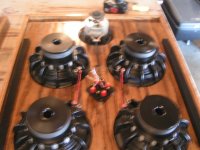 PICT0367.JPG309.8 KB · Views: 156
PICT0367.JPG309.8 KB · Views: 156 -
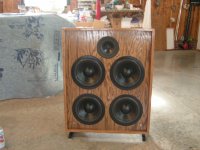 PICT0371.JPG351.6 KB · Views: 152
PICT0371.JPG351.6 KB · Views: 152 -
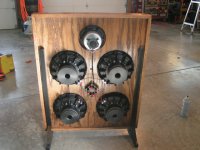 PICT0373.JPG314.1 KB · Views: 169
PICT0373.JPG314.1 KB · Views: 169 -
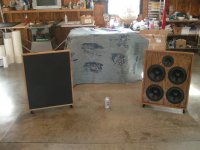 PICT0369.JPG310.6 KB · Views: 168
PICT0369.JPG310.6 KB · Views: 168 -
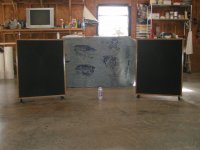 PICT0378.JPG362.1 KB · Views: 151
PICT0378.JPG362.1 KB · Views: 151
Not unlike my NaO DW.
You should be able to get great sound form them.
You should be able to get great sound form them.
An externally hosted image should be here but it was not working when we last tested it.
An externally hosted image should be here but it was not working when we last tested it.
Very nice John.
What did you use for the mid driver? I am concerned that the H653 will not be large enough. But again, I am new to OB and have not tested these yet.
Thanks
Matthew
Scan Speak 8554.
First impression,
I removed my existing mains, connected the OBs and did a sound check to make sure all the drivers were working correctly. I set the bass/mid crossover point @ 250 and the mid/high @2500. I set the gains equal on all channels and popped in some mild vocals (America) at low volume. The after walking back and forth and doing a second sound check by ear all was well. I hit pause and backed up the CD to the start, added some volume and sat down in the listening chair and hit play. Good but thin. I hit pause again, added about 6 db of gain to the bass drivers. Hit play again. Nice. Full and robust….certainly no lack of bass here. A bit too much into the midrange so I turned the crossover point down to 200hrz. That helped. The vocals are clear and well placed in the staging. The imaging is wider and deeper than my existing mains and the highs are not as harsh. This is interesting because I am using the same midrange and tweeter drivers in the OBs that I used for my exiting mains. I popped in Steely Dan Aja and pulled out the stops on the volume. WOW! Great stage and depth. These OBs do not sound thin at all, which was my main fear when I decided to build them. It may be the fairly small room but there is no need for a sub what so ever. They are a bit fatiguing at very high volume levels but I have no way to measure them yet. I will do this sometime in the next few months when I decide on a software package for measurement and design. I am sure I have enough in the design at this point to work with once I can get a measurement curve.
I am actually very surprised that the OBs are as plug and play as they are. They need work but at this point there is nothing overly objectionable. With my existing mains I had to spend weeks working on the sound and re-adjusting to get it right. It only took me about 45 minutes to get the OBs to sound better than them. I walked into the kitchen and the sound is much more balanced from the other room than it was before. I don’t know why. With my existing mains I have a much greater loss of bass when listening in another part of the house. With the OBs the sound is much more balanced when going from one room to another. Also, my next step is to build traps for my listening room. My suspicions for a long time have been that the room is too live which is why loudspeakers tend to be fatiguing at high volume. I could very well be wrong about that but taking measurements will tell the truth.
Until the next update.
Mathew.
I removed my existing mains, connected the OBs and did a sound check to make sure all the drivers were working correctly. I set the bass/mid crossover point @ 250 and the mid/high @2500. I set the gains equal on all channels and popped in some mild vocals (America) at low volume. The after walking back and forth and doing a second sound check by ear all was well. I hit pause and backed up the CD to the start, added some volume and sat down in the listening chair and hit play. Good but thin. I hit pause again, added about 6 db of gain to the bass drivers. Hit play again. Nice. Full and robust….certainly no lack of bass here. A bit too much into the midrange so I turned the crossover point down to 200hrz. That helped. The vocals are clear and well placed in the staging. The imaging is wider and deeper than my existing mains and the highs are not as harsh. This is interesting because I am using the same midrange and tweeter drivers in the OBs that I used for my exiting mains. I popped in Steely Dan Aja and pulled out the stops on the volume. WOW! Great stage and depth. These OBs do not sound thin at all, which was my main fear when I decided to build them. It may be the fairly small room but there is no need for a sub what so ever. They are a bit fatiguing at very high volume levels but I have no way to measure them yet. I will do this sometime in the next few months when I decide on a software package for measurement and design. I am sure I have enough in the design at this point to work with once I can get a measurement curve.
I am actually very surprised that the OBs are as plug and play as they are. They need work but at this point there is nothing overly objectionable. With my existing mains I had to spend weeks working on the sound and re-adjusting to get it right. It only took me about 45 minutes to get the OBs to sound better than them. I walked into the kitchen and the sound is much more balanced from the other room than it was before. I don’t know why. With my existing mains I have a much greater loss of bass when listening in another part of the house. With the OBs the sound is much more balanced when going from one room to another. Also, my next step is to build traps for my listening room. My suspicions for a long time have been that the room is too live which is why loudspeakers tend to be fatiguing at high volume. I could very well be wrong about that but taking measurements will tell the truth.
Until the next update.
Mathew.
Cool Mathew. Glad they worked out so well so quickly. Bass traps will smooth out the bass peaks and nulls in your room. Absorption panels will kill the upper range reflections that can be fatiguing. There are a lot of good links here
DIY reference threads - AudioKarma.org Home Audio Stereo Discussion Forums
.
DIY reference threads - AudioKarma.org Home Audio Stereo Discussion Forums
.
That is cool!!! Be warned that over doing it will kill the room. If you have the inclination, you might want to mess with the 703 naked to find out how many panels you actually need. Put a couple behind and in-between the speakers, one or two in each corner up high, one at first reflection points on either side of the listening position and a couple in the back of the room..... for starters.
That is a good plan. I have to be carefull and get the wife to take our 3 year old for a shopping trip for a few hours. He likes to get into everything I am doing. I have already stood in different parts of the room to find out where the worst resonances are. There are a couple of places that seem to be really bad. I am thinking if i put some big thick pieces there for a test first that will be a good start.
I added some bass traps and played with speaker positioning. The traps allowed me to raise the bass crossover point up to about 300 Hz and bring the bass level up about 3db. This resulted in much tighter and defined bass, much more mid bass punch and greatly reduced the fatigue at higher volume levels.
After quite a few listening tests moving the speakers around, I settled for a position further out from the wall (total about 3 feet) and less toe-in(almost parallel to the wall) than they were originally set. This resulted in a much wider and deeper sound stage.
Next I will be adding traps to the ceiling and the back wall (opposite the speaker wall) and playing with the laid back angle of the speakers.
Matthew
After quite a few listening tests moving the speakers around, I settled for a position further out from the wall (total about 3 feet) and less toe-in(almost parallel to the wall) than they were originally set. This resulted in a much wider and deeper sound stage.
Next I will be adding traps to the ceiling and the back wall (opposite the speaker wall) and playing with the laid back angle of the speakers.
Matthew
- Status
- This old topic is closed. If you want to reopen this topic, contact a moderator using the "Report Post" button.
- Home
- Loudspeakers
- Multi-Way
- First Open Baffle Build- Build is done